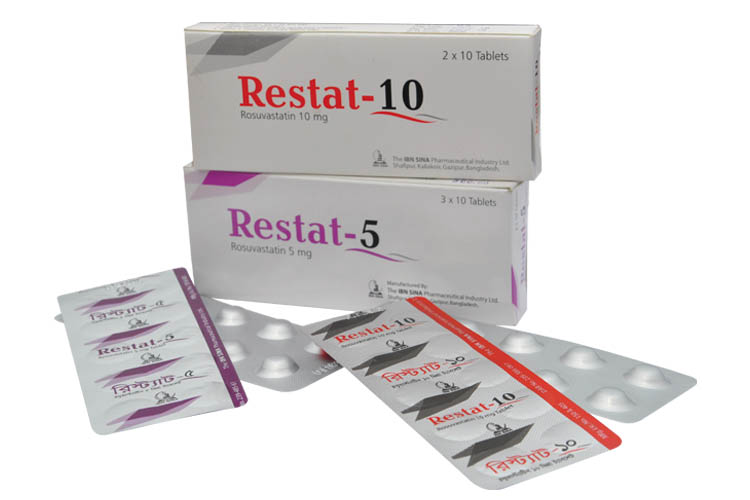
RESTAT
ROSUVASTATIN CALCIUM INN
| NAME | STRENGTH | PACK SIZE | DOSAGE FORM |
|---|---|---|---|
| RESTAT 10 MG | 10 MG | 20 S | TABLET |
| RESTAT 5 MG | 5 MG | 30 S | TABLET |
Restat 5 Tablet: Each tablet contains Rosuvastatin Calcium INN 5.20 mg equivalent to Rosuvastatin 5 mg.
Restat 10 Tablet: Each tablet contains Rosuvastatin Calcium INN 10.4 mg equivalent to Rosuvastatin 10 mg.
Rosuvastatin is an inhibitor of 3-hydroxy-3-methylglutaryl coenzyme A (HMG-CoA) reductase, the rate-limiting enzyme that converts 3-hydroxy-3-methylglutaryl coenzyme A to mevalonate, a precursor of cholesterol.
Restat is indicated for- primary hypercholesterolaemia (type IIa including heterozygous familial hypercholesterolaemia), mixed dyslipidaemia (type IIb), or homozygousfamilial hypercholesterolaemia in patients who have not responded adequately to diet and other appropriate measures.
Dose range: 5-40 mg once daily. Initially 5-10 mg once daily increased if necessary at intervals of at least 4 weeks to 20 mg once daily. Daily dose can be increased afer further 4 weeks to 40 mg only in severe hypercholesterolaemia with high cardiovascular risk and under specialist supervision. Dose for elder patients initially 5 mg once daily. HoFH: Starting dose 20 mg. In pediatric patients 10 to 17 years of age with HeFH, the usual dose range is 5-20 mg/day; doses greater than 20 mg have not been studied in this patient population.Use 40 mg dose only for patients not reaching LDL-C goal with 20 mg. Rosuvastatin can be taken with or without food, at any time of day.
Rosuvastatin is contraindicated if- Known hypersensitivity to product components. Active liver disease, which may include unexplained persistent elevations in hepatic transaminase levels. Pregnant women and women who may become pregnant, Nursing mothers.
Skeletal muscle e¿ects (e.g., myopathy and rhabdomyolysis): Risks increase with use of 40 mg dose, advanced age (>65 year), hypothyroidism, renal impairment, and combination use with cyclosporine, lopinavir/ritonavir, atazanavir/ritonavir, or certain other lipid-lowering drugs. Patients should be advised to promptly report unexplained muscle pain, tenderness or weakness. Rosuvastatin can be discontinued if signs or symptoms appear.Liver enzyme abnormalities and monitoring: Persistent elevations in hepatic transaminases can occur. Liver enzymes should be monitored before and during treatment.
Rosuvastatin is generally well tolerated. The adverse events seen with Rosuvastatin are generally mild and transient. Most commonly occurring side-e¿ects are headache, myalgia, asthenia, constipation, dizziness, nausea, abdominal pain. Uncommonly pruritus, rash and urticaria may occur. Myopathy (including myositis), hypersensitivity reactions (including angioedema), rhabdomyolysis, pancreatitis etc are the rarely occurring side-e¿ects of Rosuvastatin.
Rosuvastatin should be administered to women of childbearing age only when such patients are highly unlikely to conceive and have been informed of the potential hazards. If the patient becomes pregnant while taking this drug, therapy should be discontinued and the patient apprised of the potential hazard to the fetus. Because of the potential for adverse reactions in nursing infants, women taking Rosuvastatin should not breast-feed.
Remarkable drug interactions of Rosuvastatin are-Cyclosporine: Combination increases Rosuvastatin exposure. Rosuvastatin dose should be limited to 5 mg once daily. Gem¿brosil: Combination should be avoided. If used together, Rosuvastatin dose should be limited to 10 mg once daily. Lopinavir/Ritonavir or atazanavir/ritonavir: Combination increases Rosuvastatin exposure. Rosuvastatin dose should be to 10 mg once daily. Coumarin anticoagulants: Combination prolongs international normalized ratio (INR). Stable INR should be achieved prior to starting Rosuvastatin. INR should be monitored frequently until stable upon initiation or alteration of Rosuvastatin therapy. Concomitant lipid-lowering therapies: Use with ¿brates and niacin products may increase the risk of skeletal muscle e¿ects.
There is no specific treatment in the event of overdose. In the event of overdose, the patient
should be treated symptomatically and supportive measures instituted as required. Hemodialysis
does not significantly enhance clearance of rosuvastatin.
Store in a cool (below 25°C) and dry place protected from light and moisture. Keep out of the reach of children.
Restat 5 Tablet: Each box contains 3×10's tablet in blister pack.
Restat 10 Tablet: Each box contains 2×10's tablet in blister pack.
